10 Best Native Plants for Kenosha, Wisconsin
BY JUDITH GALLOVA | MARCH 29TH, 2023 | KENOSHA, LAWN CARE, WISCONSINFrom its charming forests to the stunning shores of Lake Michigan, Kenosha is home to an abundance of natural wonders. If you want some of its beauty to thrive in your own backyard, you should consider planting some of the best native plants for the area.
Here’s why native plants are better than non-natives:
- They’re easy to take care of in Kenosha’s climate.
- They draw in beneficial wildlife like pollinators and birds.
- Because they’re adapted to the ecosystem, they need less pesticides and fertilizers.
Native plants are not only easier to take care of but also contribute to a healthier environment. Additionally, it’s important to note that plants bloom at different times throughout the year. Therefore, it’s best to choose a wide variety of native plants that will bloom all year and provide food for birds and pollinators.
If you’re ready to start incorporating native plants into your garden or landscaping, read on about some of the best native plants for Kenosha.
In this article:
- 10 Native Plants for Your Kenosha Yard
- How to Choose the Best Kenosha Natives for Your Landscape
- Where to Find Native Plants in Kenosha
10 Native Plants for Your Kenosha Yard
1. Red Columbine (Aquilegia Canadensis)
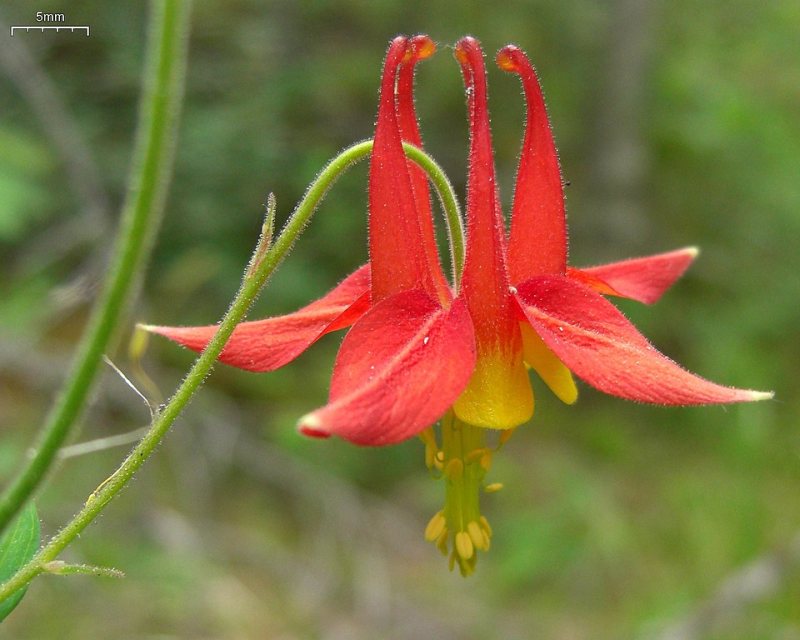
Photo Credit: Jason Hollinger / Wikimedia Commons / CC BY 2.0
The red and yellow-colored flowers of the red columbine bloom in mid-late spring and are commonly enjoyed by both bees and birds. Even though their flowers are short-lived, they can self-seed and spread throughout your garden or yard, creating a stunning display year after year.
The red columbines are low to medium-maintenance and may need a little extra care in the summer, such as cutting back old seed heads and stems. This can keep them looking tidy.
There are no known hazards to the red columbine, but it comes from the Ranunculaceae family, which has many toxic plants. Therefore, caution is still advised.
Growth habit: Flower
Mature size: up to 3 feet tall
Duration: Perennial
Foliage: Deciduous (evergreen in warmer climates)
Sunlight needs: Light to moderate shade or full sun
Soil preferences: Tolerates various well-drained soils but prefers moist, sandy or rocky soils that are fertile and moist
Water needs: Low to medium (avoid overwatering)
Potential hazards: No known hazards, but it belongs to a family of toxic plants, so practice caution
2. Wild Geranium (Geranium Maculatum)
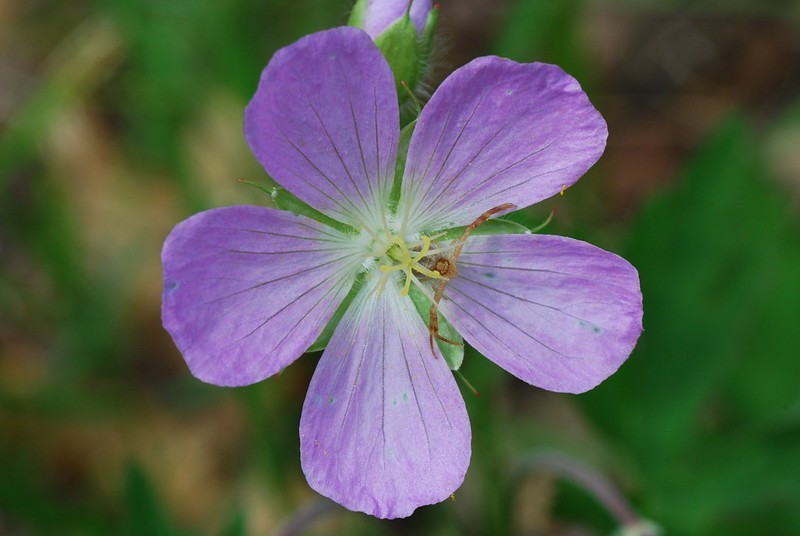
Photo Credit: Joshua Mayer / Flickr / CC BY-SA 2.0
The wild geranium, also called the cranesbill, is a beautiful perennial plant that blooms in spring and produces delicate pink or purple flowers. It attracts different kinds of pollinators and birds. Because it likes moist soil and some shade, it’s an excellent plant for woodland gardens or shady borders. Depending on the season and climate, the wild geranium may need frequent watering.
There are no known toxic effects of Geranium maculatum, but there are many other plants in the Geraniaceae family that are highly toxic. Caution is advised.
Growth habit: Flower
Mature size: 1-2 feet tall
Duration: Perennial
Foliage: Deciduous
Sunlight needs: Partial sun
Soil preferences: Moist or slightly dry, rich and loamy soil with organic matter
Water needs: Low to high, depending on the season and climate
Potential hazards: No known hazards, but it belongs to a family of toxic plants, so practice caution
3. Common Milkweed (Asclepias Syriaca)
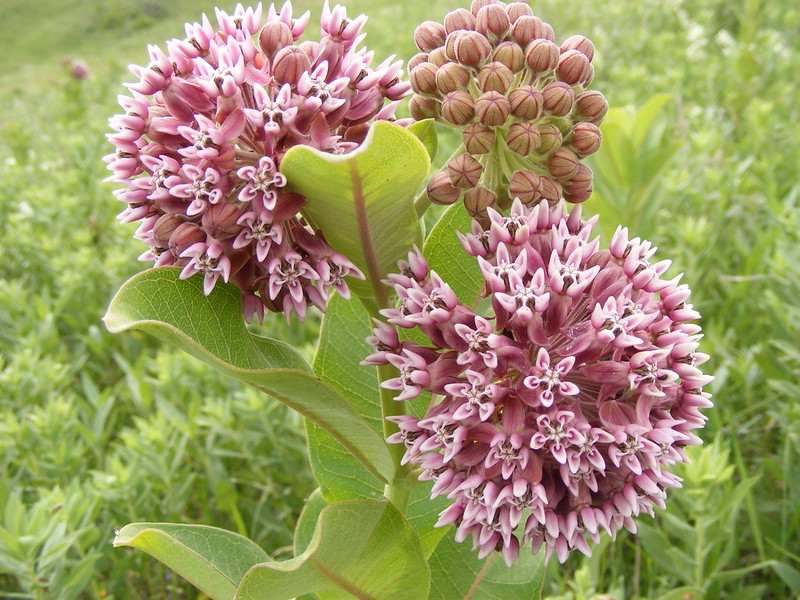
Photo Credit: USFWS Mountain-Prairie / Flickr / CC BY 2.0
The common milkweed has gorgeous pink and purple flowers that bloom in the summer. But its beauty is not all it has to offer.
If you want to provide a safe haven for monarch butterflies in your garden, planting common milkweed is a great way to do it. This forb is the sole host plant for the threatened monarch butterfly caterpillars, providing crucial habitat for their reproduction and survival. Do keep in mind, though, that this plant is toxic to other animals and to humans.
The common milkweed is generally a low-maintenance plant that needs just the right amount of water. Overwatering (as well as humid climates and plant diseases) can cause the growth of lethal fungi.
We recommend combining common milkweed with other nectar plants to provide monarchs with plenty of food.
Growth habit: Flower
Mature size: 3-5 feet tall (can grow up to 8 feet)
Duration: Perennial
Foliage: Deciduous with a few exceptions
Sunlight needs: Full sun is preferred; light shade is tolerable for some species like the A. purpurascens
Soil preferences: Average, well-drained soils; can tolerate poor or dry soils
Water needs: Low to medium (avoid overwatering)
Potential hazards: Toxic (except for monarchs)
4. Culver’s Root (Veronnicastrum Virginicum)
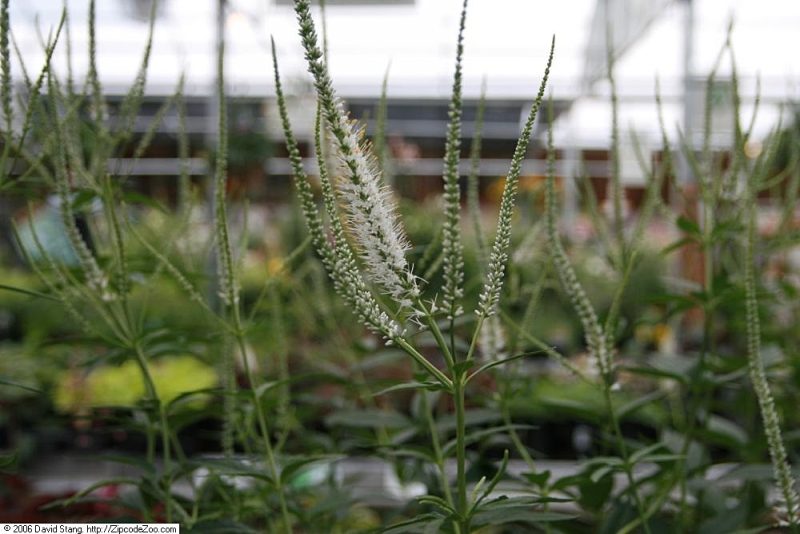
Photo Credit: Photo by David J. Stang / Wikimedia Commons / CC BY-SA 4.0
Culver’s root is a beautiful plant with spikes of flowers that range from white to pink. This tall, eye-catching plant can add an extra touch of elegance to your Kenosha garden or yard.
You can expect your culver’s root to bloom in the summer and attract pollinators as well as birds. Deadheading can be done to prolong its bloom time. If you want to keep your plant looking gorgeous and healthy, it will need some maintenance. This includes regular watering and may also involve staking.
Additionally, take note that the plant’s fresh root is toxic.
Growth habit: Flower
Mature size: 2-6 feet tall
Duration: Perennial
Foliage: Deciduous
Sunlight needs: Full sun or light shade (can’t grow in the shade)
Soil preferences: Tolerates most soils but prefers light or medium, well-drained, moist, rich soils
Water needs: Medium to high
Potential hazards: Toxic fresh root
5. Bee Balm (Monarda Fistulosa)
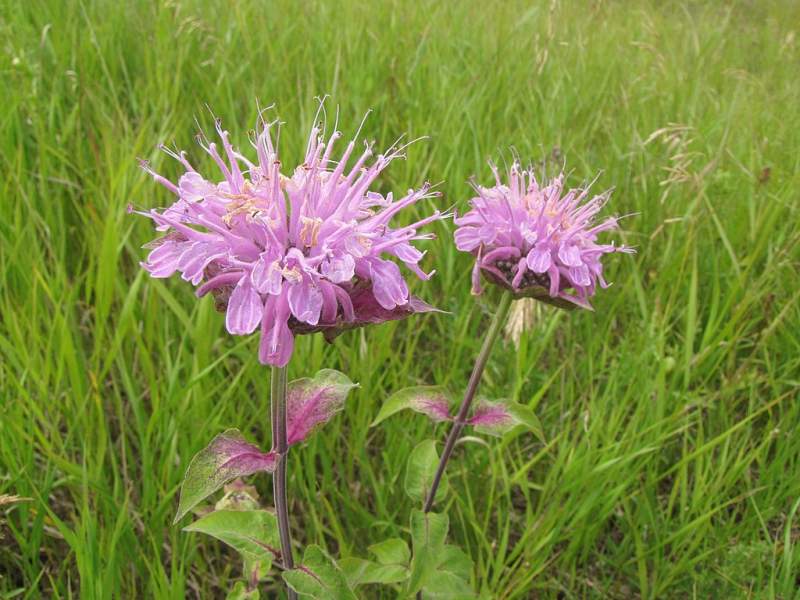
Photo Credit: USFWS Mountain-Prairie / Wikimedia Commons / Public domain
The bee balm, also called wild bergamot, is a popular native plant choice. This is a flowering plant that blooms in the summer. It’s great at attracting bees, butterflies, hummingbirds, and hawk moths to your garden. Bee balm is relatively easy to grow, with some maintenance, such as deadheading, required.
Although bee balm is often viewed as safe to consume, there are some risks (see some of them below). Consult a medical professional if you’re unsure about the safety of consuming this plant.
Growth habit: Flower
Mature size: 2–4 feet tall
Duration: Perennial
Foliage: Deciduous
Sunlight needs: Full sun or light shade
Soil preferences: Rich, moist; many kinds of soil are suitable, but flooding should ideally be avoided
Water needs: Medium to high
Potential hazards: Consuming this plant poses some risks for pregnant women, nursing women, and children; excessive consumption is unsafe for pets; practice caution
6. Northern Maidenhair Fern (Adiantum Pedatum)
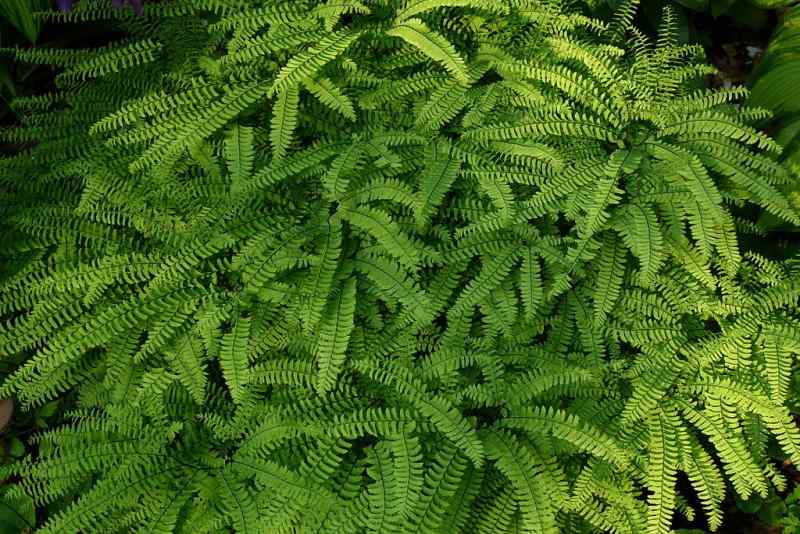
Photo Credit: Schnobby / Wikimedia Commons / CC BY-SA 3.0
The Northern maidenhair fern has unique, bright green fronds and dark brown to black stems. This plant can easily flourish in the right conditions. It blooms in the summer and is the perfect addition to a shade garden with well-drained soil.
The northern maidenhair fern isn’t considered a high-maintenance plant but does require your care to thrive. You should especially make sure that its soil stays moist, as the plant can’t tolerate dry conditions.
Because it’s a fern rather than a flower, it’s not the right plant to attract birds and pollinators. However, its lush green foliage can still add a refreshing touch to any outdoor space.
The plant is slightly toxic, so practice caution.
Growth habit: Fern
Mature size: Up to 2.5 feet tall
Duration: Perennial
Foliage: Deciduous
Sunlight needs: Light to full shade
Soil preferences: Rich, moist, well-drained soil
Water needs: Medium to high (but don’t overwater; always keep soil moist but not wet)
Potential hazards: Slightly toxic; the plant contains carcinogens; it may also contain thiaminase, which can be destroyed by heat or thorough drying
7. Stiff Goldenrod (Solidago Rigida)
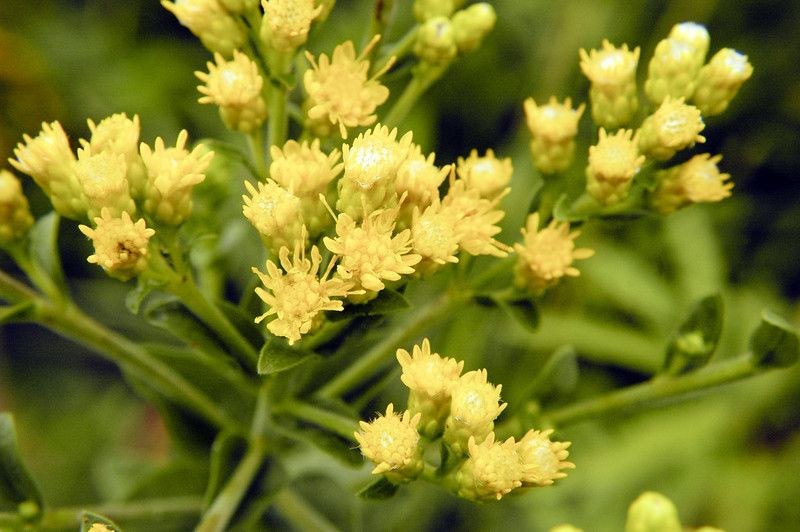
Photo Credit: Frank Mayfield / Flickr / CC BY-SA 2.0
The lovely stiff goldenrod flowers bloom in the late summer to early fall and thrive in full sun to partial shade. They attract pollinators such as bees and butterflies in the summer and birds in the fall. These flowers are relatively easy to care for, resistant to drought, and can grow up to 5 feet tall.
Because stiff goldenrods are self-seeding, they spread quickly and may require some maintenance to prevent them from taking over other areas of the garden. However, their vibrant color and ability to attract pollinators and birds make them a great addition to any Kenosha garden.
Growth habit: Flower
Mature size: 1–5 feet tall
Duration: Perennial
Foliage: Deciduous
Sunlight needs: Full sun
Soil preferences: Well-drained, poor, dry to medium moist, average soil (in rich moist soils, the plant may over
Water needs: Low to medium
Potential hazard: None known
8. Little Bluestem (Schizacyrium Scoparium)
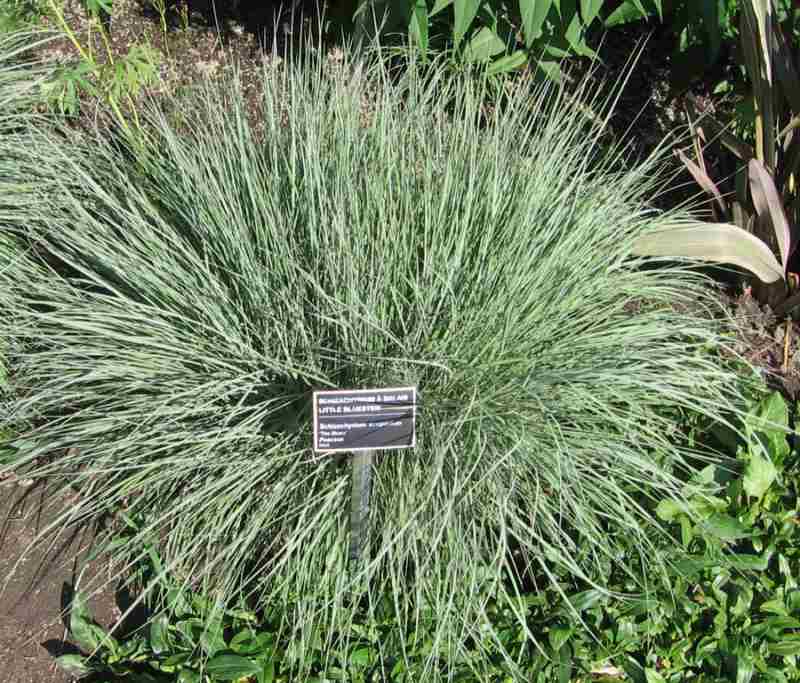
Photo Credit: Montrealais / Wikimedia Commons / CC BY 3.0
The blue-green leaves of the little bluestem turn a beautiful coppery orange in the fall, adding color to the landscape. Once established, it’s drought-tolerant and requires minor maintenance.
You should cut it back to the ground in late winter and early spring so that it can grow back fresh and look beautiful year after year. Moreover, take note that the little bluestem can be an invasive species if not properly maintained.
The plant flowers in late summer and early fall. It’s also a great food source for birds.
Growth habit: Grass
Mature size: 2–4 feet tall
Duration: Perennial
Foliage: Deciduous
Sunlight needs: Full sun
Soil preferences: Average soil that’s dry to medium moist and well-drained, but tolerates various soil conditions, including light, heavy, rocky, and poor, and infertile soil
Water needs: Low
Potential hazard: None known
9. Heart-Leaved Aster (Symphyotrichum Cordifolium)
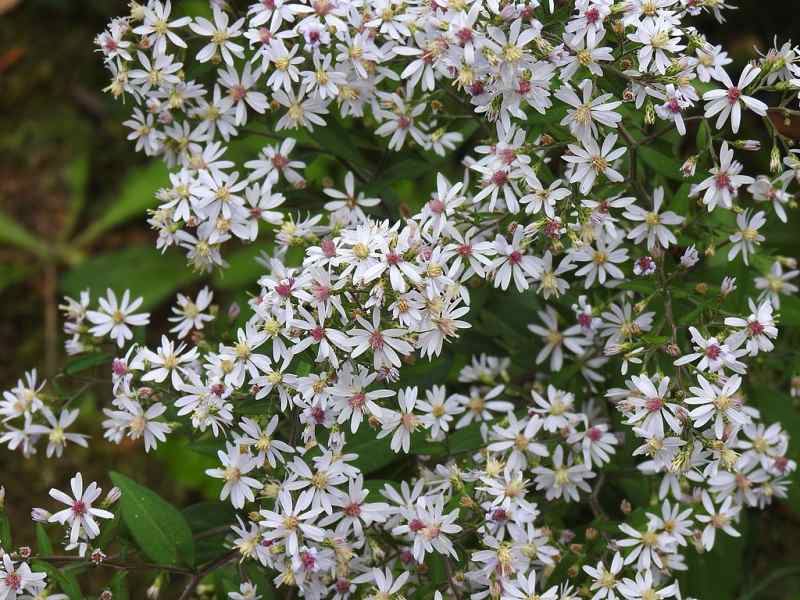
Photo Credit: Alexis Godin / Wikimedia Commons / CC BY 4.0
The heart-leaved aster, also called heart-leaved American-aster and blue wood aster, is a stunning blue-purple wildflower that blooms in late summer and early fall. It’s adaptable and resilient, so it’s not difficult to care for.
Birds love the heart-leaved aster for its seeds, and butterflies and bees are drawn to its nectar. If you’re looking to attract beneficial wildlife to your garden, this plant is a great choice.
Growth habit: Flower
Mature size: 2–5 feet tall
Duration: Perennial
Foliage: Deciduous with a few exceptions
Sunlight needs: Light to full shade or full sun
Soil preferences: Average, well-drained, dry to moist soil
Water needs: Low to medium
Potential hazard: None known
10. New England Aster (Symphotrichum Novae Angliae)
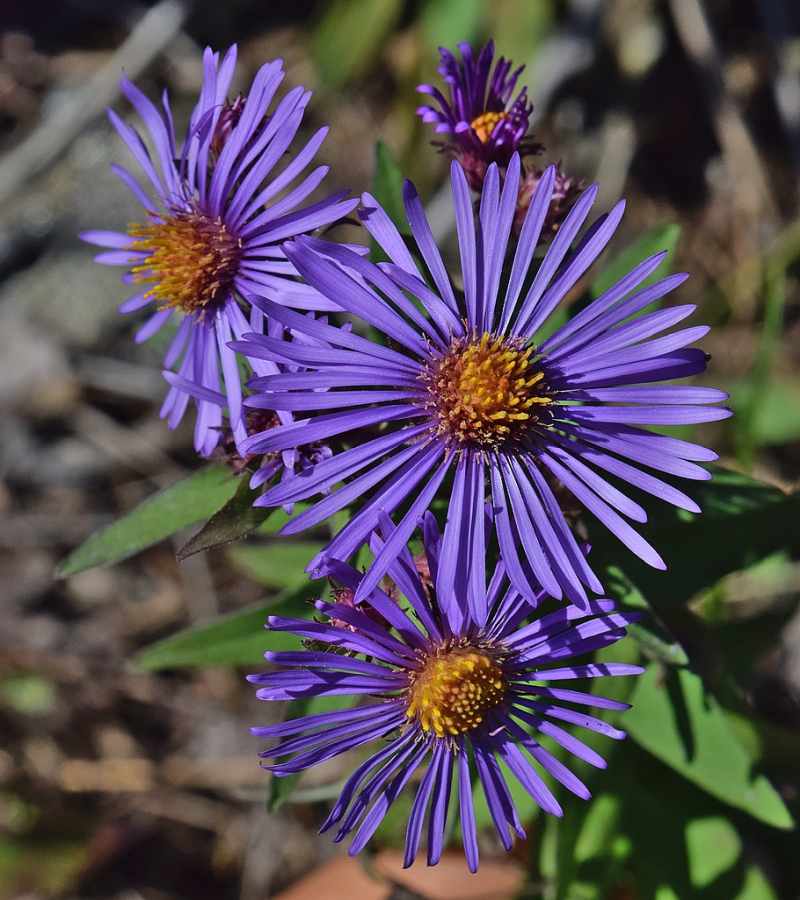
Photo Credit: The Cosmonaut / Wikimedia Commons / CC BY-SA 2.5 CA
The New England aster is a classic option for adding a pop of purple to your garden. It blooms from late summer to early fall and is a frequent nectar source for bees and butterflies.
The plant prefers moist, rich, well-drained soil and low to medium watering. But if you don’t remember to water it regularly, don’t worry, as it can live off rainwater. The New England aster can grow up to 6 feet, but you can cut back the stems of the flower in June and early July. This will encourage bushier growth and more flowers in the late summer.
Growth habit: Flower
Mature size: Up to 6 feet tall
Duration: Perennial
Foliage: Deciduous
Sunlight needs: Full sun
Soil preferences: Moist, rich, well-drained soil
Water needs: Low to medium
Potential hazard: None known
How to Choose the Best Kenosha Natives for Your Landscape
The right plants for your landscape depend on various factors, including the amount of sunlight, soil type, and water needs. When considering which plants to buy, consider your lawn’s unique characteristics and how much you’ll be willing to maintain them. Research how to take care of each plant thoroughly, including what they need in terms of mulch, fertilizer, and so on.
Moreover, make sure your plant is able to thrive in Kenosha’s hardiness zone before you buy it. Kenosha’s hardiness zone is 5b, indicating that its minimum average temperature is between -10 and -15 degrees Fahrenheit. It’s important to choose plants that can withstand these temperatures. Of course, all the plants mentioned in this article can thrive in Kenosha’s hardiness zone.
As we mentioned at the beginning of this article, we suggest getting plants that bloom at different times of the year so that pollinators and birds have a food source in your garden throughout the seasons.
Where to Find Native Plants in Kenosha
You might find some of these native plants in your yard already, but if you want to add more to your garden, you can get them ethically by purchasing from local native plant nurseries. It’s important to choose plants that are locally sourced and not taken from the wild, as this can harm natural ecosystems.
Here are a few of Wisconsin’s local nurseries:
- Victor Hlavacek Florist
- Meinke Garden Center
- Milaeger’s
- Horvat Nurseries
- Prairie Future Seed Company (recommended by the Wisconsin Department of Natural Resources)
There are various resources to help homeowners find the right southeastern Wisconsin native plants. You can view a full list of the Wisconsin Department of Natural Resources‘ recommended Wisconsin nurseries here. If you want to plant milkweed, you can use the recommended Milkweed Finder Tool. You can also view Kenosha nurseries on Yelp. If you’re adding new plants, there may be other areas of your garden that need attention. Just like plants, grass types also require specific conditions to thrive, so make sure that you get one of the best grass types for Kenosha. Moreover, consider hiring one of WikiLawn’s Kenosha, WI lawn care pros to keep your lawn green and healthy.
Main Photo Credit: Dj53144 / Wikimedia Commons / CC BY-SA 4.0